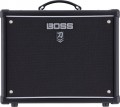The type
of line output provided in the design of the combo amplifier.
This output, as the name suggests, provides a line-level analogue audio signal. In this case, unlike the preamplifier output (see above), the signal level at the line output is not adjustable. This interface is mainly used to connect recording devices, although it can also be used to output a signal to an external amplifier (in fact, in the absence of a Pre-Amp output, the only option for such a connection is a line input). And the types of connectors used for the line output can be as follows:
—
Mini-Jack (3.5 mm). The classic "minijack" is small in size, but inferior to larger connectors in terms of reliability and connection quality; compactness in the case of combo amplifiers most often does not play a decisive role. That is why such exits are extremely rare, mainly in the most compact “amps”.
— Jack (6.35 mm). Connector, quite popular in stationary audio equipment, including pretty advanced. Theoretically, it can even provide a balanced connection (see below), but this feature is far from mandatory, its presence should be specified separately. Also note that a 3.5 mm mini-Jack plug can also be connected to such a jack using a simple adapter.
—
Balanced XLR. The XLR output is a characteristic round three-pin connector with a balanced connection type. With this connection, the signal is transmitted over thre
...e wires instead of two, and in a special way, due to which the interference induced on the wire is extinguished. This allows even fairly long cables to be used without sacrificing signal purity, making this type of connection suitable even for professional audio equipment. Actually, XLR is also considered a professional interface — both because of the ability to work with a balanced signal, and because of the rather large dimensions and increased reliability (connectors are often equipped with locks for fixing plugs).
— Jack/XLR. Usually, in this case, a combined connector is meant, combining a 6.35 mm Jack and XLR. On the features of both, see above; and the combo jack looks like an XLR jack, complete with a hole for a Jack plug in the centre.
Jack/RCA. The presence in the device of two linear outputs at once, with different types of connectors. See above for more details on the Jack interface. And RCA is a connector for a coaxial cable with a “tulip” plug; this is one of the most popular interfaces in entry-level and mid-range stationary audio equipment, but it is relatively rare in guitar amplifiers.
— Corporate. A proprietary connector that does not belong to any generally accepted standard. It is mainly used to connect equipment of the same brand as the combo.
